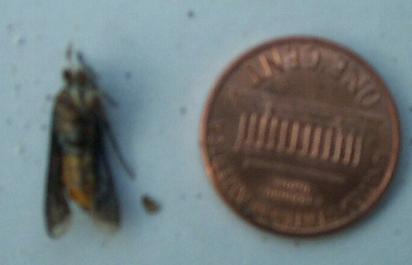
This is perhaps the most feared creature to anyone that grows any plant in the gourd family. It is a small, red-brown flying moth with narrow wings that flies during the day. It moves just like a wasp or a bee, flying with great skill and speed. In fact, due to its un-moth-like shape, speed, and behavior the casual observer could easily mistake it for some kind of stinging insect...which suits the Squash Vine Borer just fine.
The adult moth usually emerges from cocoons left hibernating in the soil or plant debris from the previous year in late June. As soon as it is up and flying about, it seeks out pumpkin, squash, and gourd plants to lay single eggs at the base of each vine. One borer adult can easily infest every plant in a small garden with a single pass.
The eggs are small, flat, disk shaped, dried blood red, and approximatly the size of the tip of a pencil. After about a week of sitting glued to the squash plant, the eggs hatch into maggot-like larvae that imediatly burrow into the stalk of the vine. Before long, the grubs are inside of your plant, eating the delicate inner flesh of the hollow vine.
Infested vines may look okay at first, but the grub is slowly girdling the plant by eating away at the nutrient transport system of the plant. Before long, any fruit on the vine stops growing and rots. The leaves wilt, even though the plant may be being watered generously. Finally, the grub kills the vine, ruining the plant by basically eating it from the inside out.
This pest is dangerous in so many ways. First off, a single egg can kill, if the larva hatches near the base of the vine (were the adult moth usually lays them) The adult moth is able to fly fast and far, and has good enough scent to track down vines from up to a mile away. Even worse, once the grub has hatched and is in the vine, most pesticides, organic or not, cannot reach the grub to kill it as it is inside of the plant. Lastly, if your not observant, you will not even know you have this insect till your plant wilts from the damage, and by then it is usually to late.
What can you do? Be observent and treat your plants at the first sign of infection. Keep a plastic yellow container of water with a few drops of dish soap in our garden at all times, the adult moths are attracted to the color yellow, will fly into the water, and drown. If you see squash vine borer moths floating in your yellow deathtrap, its time to take action.
For those organic gardeners around here, it is possible to carefully check your plants and remove the eggs by hand. Look especially where the base of the vine meets the soil. The moths can and will lay eggs anywhere on the vine, even on leave stems, so it may be hard to find all the eggs on a large plant.
Another organic method is to prevent the moths from even reaching your plants. Floating row covers can protect young plants, while carefully wrapping tin foil around the base of the vine can frustrate the adult moth. The problem with both these methods is that gourd vines usually grow to immense sizes, and there is going to be no way you could find a row cover/tin foil package big enough to cover the entire plant.
If the eggs have already hatched, and the grubs are inside the vine, yer job has gotten a lot tougher. Investigate your vines if you suspect squash vine borer activity. Tiny holes in the vine with pulpy chewed up looking matter (called frass) can indicate the entry hole of a borer. Pesticides will not harm the grub in the stem, so you have to go after it. Slitting the vine and removing the grub is one, rather dangerous way. Be sure to place the injured part of the vine under soil to help it heal and grow new roots.
You can also hunt for grubs at night. Using a bright flashlight, hold yer vine up to the flashlight at night to illuminate the vine. You can see the silhouettes of the insects inside. Then, using a long pin, peirce the stem and the insect too. This method is less invasive then slitting the vine, but the downside is that you have to be out in the dark, with a cloud of mosquitoes circling you.